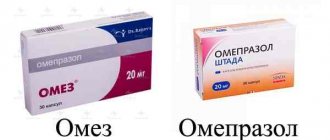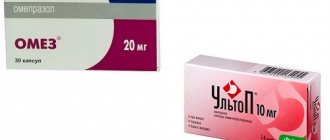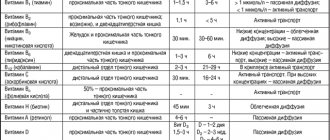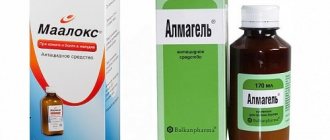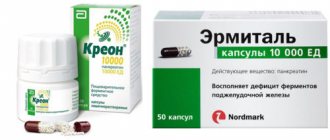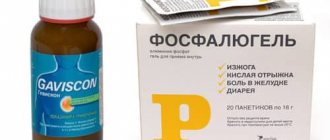Updated: 04/23/2021 15:13:42
Expert: Abramova Tsilya
Proton pump inhibitors confidently occupy a leading position among drugs for the treatment of diseases of the digestive tract. They help with gastritis and peptic ulcers - they reduce the formation of hydrochloric acid, prevent the appearance of ulcers, and prevent the progression and relapse of the disease. In combination with other medications, they improve the patient’s condition - relieve pain, heartburn, nausea and other symptoms.
Nolpaza and Omez are proton pump inhibitors. They belong to the same group of drugs, but differ in composition. Various active components determine differences in the action of drugs. Read the article for a detailed review of each drug.
Important to remember! Proton pump inhibitors are not intended for self-medication. Drugs in this group are prescribed by a gastroenterologist only after a complete examination of the patient and an accurate diagnosis.
Omez - description
The medicine Omez is produced in India. As a proton pump inhibitor, omeprazole contained in the drug inhibits the activity of special enzymes that are secreted by the parietal cells of the stomach. This causes a decrease in the production of hydrochloric acid, which is present in increased quantities in patients with gastritis and a number of other diseases.
Omeprazole is activated precisely in the acidic environment of the stomach, affecting the secretory tubules.
Thanks to the highly effective action of Omez, the level of basal and stimulated acid secretion decreases, and in the latter case, the work of the product does not depend on the cause of the irritating factor.
The drug is available in dosages of 10, 20 and 40 mg, while when taking 20 mg, the effect develops within an hour. Up to 50% of the substance continues to act throughout the day, but maximum effectiveness is achieved with a course of administration after 4 days. 3 days after the end of therapy, the secretion of hydrochloric acid is restored.
Omeprazole - what kind of drug?
Like Omez, Omeprazole is available in the form of capsules, which contain 20 or 40 ml of the main substance - omeprazole. The medicine under this trade name is represented by most large pharmaceutical companies, Teva, Sintez, Kanonpharma and others.
Manufacturers indicate that the maximum effect in the body is created 2 hours after the start of administration, although it begins after an hour.
Due to the presence of a similar active substance, the effect of Omeprazole is the same. In patients with ulcers, gastritis, and erosions, it helps maintain the pH level by 3.0 for up to seventeen hours. The drug is processed by the liver, so if the organ’s function is insufficient, it should be taken with caution.
Like Omez, this remedy may have side effects:
- discomfort in the stomach;
- diarrhea, constipation;
- flatulence;
- nausea, vomiting;
- changes in blood composition (rare);
- increased AST, ALT of the liver;
- taste disturbances.
In patients with liver pathologies, Omeprazole sometimes caused toxic hepatitis - inflammation of the liver tissue, which was transient in nature. Allergic reactions are rare, they mainly concern skin forms - itching, rash, redness, erythema. Bronchospasm, Quincke's edema and other systemic forms are much less common. Also, medications based on this substance can manifest themselves as hyperhidrosis, swelling of the legs, and the growth of cysts in the stomach during long-term therapy (cysts resolve on their own).
WE RECOMMEND THE ARTICLE!
Kvamatel is used in the treatment of stomach ulcers, pancreatitis and gastroduodenitis. Read more >>
Comparison of drugs
The difference between Omeprazole and Omez in price is noticeable. The first drug is much cheaper - it can be purchased for 25 rubles/30 tablets of 20 mg, although from different manufacturers the cost reaches up to 95 rubles. The second remedy in the same quantity and dose costs at least 180 rubles.
There are also differences in the composition of the auxiliary components, which is important for people with allergies to these substances. For a cheaper product, the list is as follows:
- potassium phosphate;
- calcium carbonate;
- sucrose;
- mannitol;
- titanium dioxide;
- polyethylene glycol;
- hypromellose;
- sodium lauryl sulfate and others.
The shell of the drug even contains acetic acid and many dyes. Omez’s composition is less “scary” - it only contains poloxamer, meglumine, hypromellose, mannitol and crospovidone.
There are no differences in indications between the drugs; these are GERD, reflux esophagitis, ulcers, and other hypersecretory conditions.
Omeprazole is not available in a 10 mg dose, which may be important for some patients. The difference is that Omez has a special children’s uniform marked “insta”. The drug is produced in the form of 20 mg powders, dissolves in water, and is approved for use from 2 years of age.
There are no differences in general contraindications between the drugs, they are the same - intolerance, pregnancy, lactation, age under 18 years. It is better to take medications under the supervision of a doctor for kidney and liver failure.
Precautionary measures
Omez and Nolpaza have similar adverse reactions. The most common symptoms that occur are:
- decreased blood cell levels – anemia, leukopenia, thrombocytopenia;
- hypersensitivity reactions: allergic rash, angioedema;
- insomnia or increased excitability;
- headache, dizziness, drowsiness;
- visual and hearing impairment;
- bronchospasm;
- abdominal pain, stool disturbance, flatulence;
- excessive sweating;
- peripheral edema.
If undesirable reactions occur, you should stop taking the drug and consult a doctor.
During pregnancy and breastfeeding, only Omez is approved for use. Nolpaza is not prescribed in these situations.
What do the experts say?
Both products are generics of the drug Losek, which was released back in 1989 in Sweden. Thus, they are created on the basis of the original product, but they differ in purification, the composition of additional substances, and they want to completely replace it in terms of the main component.
According to gastroenterologist Natalya Antipova, it cannot be said that Omez is more effective than Omeprazole in terms of therapeutic effects.
Both remedies work at the same speed, have a prolonged effect, and are excellent for gastritis and other hypersecretory diseases.
The difference is great in the degree of purification, the quality of production of the main component, and the set of additional substances, therefore Omez has a lower risk of side effects.
If we compare the severity of unpleasant effects, even with the same list of cheaper products, they are more serious. Thus, nausea occurs when taking Omez much less frequently than when treating with Omeprozole. Moreover, there is Omez-DSR, which contains domperidone, an antiemetic component. It can be taken if the patient has such reactions. The list of auxiliary components of the Indian product is more precise; they are more expensive, which affects the price. But the danger of developing negative actions from the product is minimized as much as possible.
Drug analogues
If we compare these drugs and analogues, the latter include other components from the group of proton pump inhibitors and are an order of magnitude higher:
| A drug | Compound | Price, rubles |
| Nolpaza | Pantoprazole | 230 |
| Nexium | Esomeprazole | 500 |
| Emanera | Esomeprazole | 350 |
| Pantoprazole-Canon | Pantoprazole | 220 |
| Rabiet | Rabeprazole | 360 |
| Lancid | Lansoprazole | 300 |
None of these medications should be taken uncontrolled without examination. They can mask the symptoms of malignant stomach diseases, so it is important to first visit a doctor and undergo the necessary procedures.
Razo or Omez tablets – which is better?
Both drugs belong to the group of proton pump inhibitors, therefore they have common indications. They are prescribed for treatment:
- stomach ulcers, erosions;
- gastritis with high acidity;
- pancreatitis and cholecystitis;
- GERD;
- pathological hypersecretion of acid.
Medicines help reduce the amount of hydrochloric acid in the gastric juice, therefore protecting the mucous membrane from inflammation and irritation. While taking Razo and Omez, rapid healing of existing defects occurs. When taking NSAIDs, the drugs prevent the development of gastritis and ulcers. There is also a difference between medications:
- Omez contains omeprazole, Razo - a more modern component rabeprazole, and the first product is presented in dosages of 20 and 40 mg, the second - 10 and 20 mg;
- It is much more convenient to take - its work does not depend on food consumption, and it is advisable to drink Omez 30 minutes before meals;
- Razo's effect is more powerful - it lasts up to 48 hours and occurs after 30-60 minutes, while Omez's effect lasts up to 24 hours and develops after 2-3 hours;
- Even taking antacids does not affect the work of rabeprazole, which cannot be said about omeprazole;
- price Razo – 340 rubles/30 tablets, Omeza – 165 rubles/30 capsules in a dosage of 20 mg.
Razo is usually prescribed for more severe forms of pathologies. It is more convenient, acts faster, and also eliminates the development of withdrawal syndrome. Rabeprazole more consistently maintains low acid levels between doses, which is very important for GERD. This substance also better relieves stomach pain in overweight people. The only negative is the price, but the choice of drug should be left to the gastroenterologist.
Application diagram
Proton pump inhibitors are prescribed in the following situations:
- peptic ulcer of the stomach and duodenum - comprehensive treatment and prevention of relapses;
- gastroesophageal reflux disease;
- other conditions associated with excessive production of hydrochloric acid: stress gastric ulcers, systemic mastocytosis, etc.;
- eradication of Helicobacter pylori in peptic ulcer disease.
The treatment regimen is determined by the doctor, taking into account the patient’s age and the severity of his condition. The course of treatment lasts 4-8 weeks. Typically, proton pump inhibitors are prescribed half an hour before meals.
Omizak or Omez?
Drugs from the group of proton pump inhibitors with the active substance omeprazole - Omizak and Omez - are very popular among gastroenterologists' prescriptions. Medicines suppress the function of the proton pump, a special mechanism located in the gastric mucosa. As a result, the degree of irritation of the walls by acid decreases, and tissues begin to regenerate faster.
Omizak and Omez are recommended for any diseases that are accompanied by hypersecretion of acid and resulting inflammation:
- gastritis and peptic ulcer;
- inflammation of the duodenum;
- stress ulcer;
- hereditary syndromes that cause increased acidity;
- GERD.
Both medications can be taken as part of complex therapy against Helicobacter pylori bacteria, as well as for the prevention of ulcers when treated with NSAIDs. The differences between the drugs are insignificant, as is the price - about 165 rubles for 30 tablets, both Omez and Omizak are produced in India. Usually Omez is more often recommended due to the existence of its other forms:
- Omez-Insta (powder), allowed for children from 2 years old (Omizak - only from 12 years old);
- Omez-D (tablets) additionally contain domperidone, an antiemetic component;
- Omez-DSR (capsules), a modified-release drug, has a prolonged effect.
Otherwise, the drugs do not differ, so when prescribing the usual form of Omez, it can be replaced with Omizak.
What's inside: composition and form of release of drugs
Omez and Nolpaza belong to the same group of drugs. These are proton pump inhibitors (PPIs), or H+-K+-ATPases, known anti-ulcer drugs. Used in complex therapy of gastric and duodenal ulcers, gastritis with increased secretion of gastric juice.
Detailed characteristics of the drugs are presented in the table.
| A drug | Nolpaza | Omez |
| Active substance | Pantoprazole sodium sesquihydrate | Omeprazole |
| Dosage | 40 mg | 20 mg |
| Release form | Film-coated tablets | Capsules |
| Vacation at the pharmacy | On prescription | On prescription |
| Manufacturer | KRKA (Slovenia) | Dr. Reddy's Laboratories Ltd. (India) |
| Price | 200-400 rubles | 50-150 rubles |
Omez or De-Nol
The drug De-Nol belongs to the group of gastroprotectors. It is based on bismuth citrate - an astringent, antimicrobial, anti-ulcer and cytoprotective substance. In the acidic environment of the stomach, bismuth interacts with proteins, forming a protective film on the mucous membrane. Under this film, rapid epithelization of defects occurs - ulcers, erosions. De-Nol also has the following effects:
- increasing the resistance of the mucous membrane to irritation;
- negative effect on Helicobacter pylori infection.
The remedy is indicated for ulcers and gastritis, irritable bowel syndrome, functional dyspepsia. Omez belongs to a completely different drug group - proton pump inhibitors. It inhibits a special enzyme, which causes a decrease in the production of hydrochloric acid. The drug does not create a protective film, but by inhibiting acid secretion it has a protective effect for the gastric mucosa. Indications for Omez are associated with any conditions that are accompanied by high acidity - ulcers, gastritis, erosions, GERD, reflux esophagitis.
Contraindications to taking the drugs are almost the same - pregnancy, lactation, severe renal failure, but Omez is allowed from the age of 12, and De-Nol from the age of 14. The cost of De-Nol is an order of magnitude higher than Omez - 165 and 320 rubles, respectively. It is impossible to determine which medicine is more effective. The drugs are not analogues in structure and action, therefore they cannot be interchangeable and are prescribed by a doctor in different situations.
Assessing the effectiveness of drugs
Professor S. Yu. Serebrova conducted a comparative analysis of two proton pump inhibitors - omeprazole and pantoprazole (Omez and Nolpaza). The results were published in the journal "Attending Physician".
Important aspects:
- According to a meta-analysis, which systematizes the results of the use of PPIs in different categories of patients, we can conclude: pantoprazole is a less active drug compared to omeprazole.
- Clinical studies prove the same therapeutic effectiveness of pantoprazole and omeprazole in the treatment of peptic ulcers and reflux esophagitis.
- The Cochrane Library database also contains references to proton pump inhibitors. The analysis shows that drugs in this group effectively cope with the manifestations of functional dyspepsia and reliably suppress the secretion of gastric juice. PPIs have also proven themselves in the treatment of peptic ulcers.
